Guide to Shark Identification
Order Lamniformes —
Mackerel Sharks
The mackerel sharks are a diverse group of large, spectacular sharks including some of the best-known and most notorious species. Characteristics shared by all lamnoid sharks are as follows:
 nictitating eyelids absent
nictitating eyelids absent- mouth behind front of eyes
- five pairs of gill slits
- both dorsal fins without spines
- anal fin present
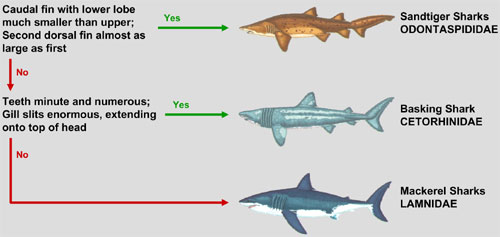
Key to selected lamnoid families
Odontaspididae | Cetorhinidae | Lamnidae
Family Odontaspididae - Sand Tiger Sharks
Since only one member of this family is regularly encountered by divers, for our purposes, characteristics of the odontaspidid family may be considered the same as for the Sandtiger Shark (below).
Sandtiger (Carcharias taurus)
What to Look For:
- body stout, with flattened snout, high, sloping ‘nape’, and thick tail stalk without lateral keels
- anterior teeth prominent and fang-like, each with a large, smooth-edged central cusp flanked by smaller basal cusplets
- both dorsal fins and anal fin angular, equally large and broad-based
- first dorsal fin located posterior on back, originating closer to pelvic fins than the pectorals
- upper precaudal pit present
- caudal fin strongly heterocercal, with well-developed lower lobe
- flank pigmentation often features reddish-brown spots scattered on light brown background

Size: average length 5 to 6 feet (1.5 to 1.8 metres), maximum to 10.5 feet (3.2 metres)
Habitat: Rocky Reefs, Coral Reefs
Distribution: Argentinean, Caribbean, Western North Atlantic, Eastern North Atlantic/Mediterranean, West African, Southern African, Madagascaran, Arabian, Indian, Southeast Asian, Western Australian, Southeastern Australian/New Zealand, Northern Australian, Japanese
Ecological profile of the Sandtiger
Family Cetorhinidae — Basking Shark
An enormous filter-feeder, the Basking Shark is the sole representative of its family. As such, the species characteristics (below) are equivalent to those for the cetorhinid family.
Basking Shark (Cetorhinus maximus)
What to Look For:
- body fusiform and elongate, with conical head, narrow tail stalk supported by stout lateral keels
- enormous gill slits that nearly encircle the head, expand spinnaker-like while feeding
- mouth huge, subterminal with very light-colored tissue inside
- first dorsal fin much larger than second dorsal or anal fins
- origin of first dorsal fin completely behind pectoral fins
- caudal fin lunate, with lower lobe nearly as large as the upper
- pigmentation pattern typically features irregular pale streaks and splotches
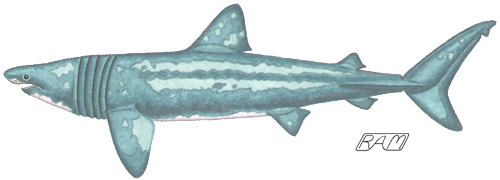
Size: average length 23 to 30 feet (7 to 9 metres), maximum to at least 40 feet (12 metres)
Habitat: Rocky Reefs, ?Deep Sea, Polar Seas
Distribution: Arctic, Central Pacific, South Pacific, Temperate Eastern Pacific, Tropical Eastern Pacific, Chilean, Argentinean, Western North Atlantic, Eastern North Atlantic/Mediterranean, Southern African, Southeast Asian, Western Australian, Southeastern Australian/New Zealand, Japanese
Ecological profile of the Basking Shark
Family Lamnidae — Mackerel Sharks
The mackerel sharks are a small family of large, spectacular sharks, including the most infamous and the best gamefish among sharks. All lamnids share the following characteristics:
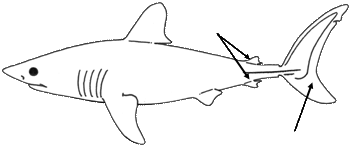 body heavy, spindle-shaped with conical snout and narrow tail
stalk supported by stout lateral keels
body heavy, spindle-shaped with conical snout and narrow tail
stalk supported by stout lateral keels- long gill slits, extending about 2/3 the depth of the throat
- mouth armed with teeth that are relatively few but large
- second dorsal and anal fins small with pivoting bases
- caudal fin lunate, with lower lobe nearly as large as the upper
White Shark (Carcharodon carcharias)
What to Look For:
- teeth triangular and serrated
- eyes small but conspicuous, black with no visible pupil
- origin of first dorsal fin over rear base of pectoral fins
- sharp demarcation between dark upper surfaces and white lower surfaces; trailing edge of pectoral fin white, underside of pectoral tips black; a black spot occurs at the pectoral axil (‘armpit’) in some individuals
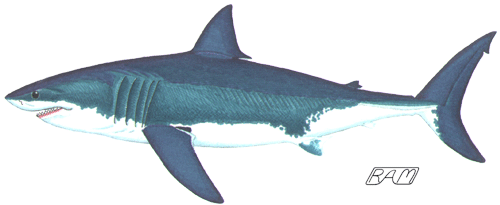
Size: average length 10 to 13 feet (3 to 4 metres), maximum to at least 20 feet (6 metres)
Habitat: Sandy Plains, Rocky Reefs, Kelp Forests, Coral Reefs, Open Ocean, Deep Sea
Distribution: Central Pacific, Temperate Eastern Pacific, Tropical Eastern Pacific, Chilean, Argentinean, Caribbean, Western North Atlantic, Eastern North Atlantic/Mediterranean, West African, Southern African, Southeast Asian, Western Australian, Southeastern Australian/New Zealand, Japanese
Ecological profile of the White Shark
Shortfin Mako (Isurus oxyrinchus)
What to Look For:
- anterior teeth blade-like, recurved and smooth-edged
- eyes moderately large, dark and conspicuous
- origin of first dorsal fin over free rear tip of pectoral fins
- second dorsal and anal fins small with pivoting bases
- flanks often a brilliant ultramarine, undersurfaces pure white, including underside of snout
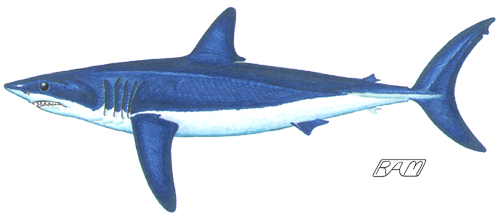
Size: average length is 6 to 8 feet (1.8 to 2.5 metres), maximum about 13 feet (4 metres)
Habitat: Rocky Reefs, Kelp Forests, Coral Reefs, Open Ocean
Distribution: North Pacific, Central Pacific, South Pacific, Temperate Eastern Pacific, Tropical Eastern Pacific, Chilean, North Atlantic, South Atlantic, Argentinean, Amazonian, Caribbean, Western North Atlantic, Eastern North Atlantic/Mediterranean, West African, Southern African, Central Indian, Madagascaran, Arabian, Indian, Southeast Asian, Western Australian, Southeastern Australian/New Zealand, Northern Australian, Japanese
